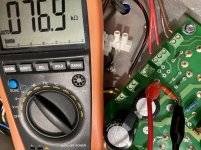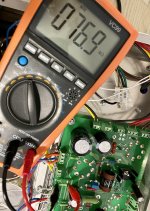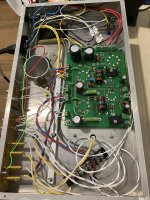- Rectifier tube has been checked (pin 2 and 7 are connected) plus it glows
when turned on. --> Can this guarantee that tube is operational?
That only means the filament is ok. It has to be tested with high voltage on the anodes.
Last edited:
Hi!!
I'm back on the project of finishing my SSE amp (3 years stopped )
)
So I've done some readings on the different resistors and found out that 1 was wrong (i'm starting to doubt I can read numbers.... ) so I just changed the resistor for the correct one.
) so I just changed the resistor for the correct one.
The problem I can see now is with R2 and R4 (R2 is the one that fired up) where the reading are showing 77k ohm in both cases. (attached pic) The thing is that the value on R4 shows it is a 150k ohm and the color code on R2 shows the same.
So my question are:
- Could those resistors be damaged?
- Should I change them?
- Could the reading be due so something else and it can stay like this?
Thanks!!!!
I'm back on the project of finishing my SSE amp (3 years stopped
So I've done some readings on the different resistors and found out that 1 was wrong (i'm starting to doubt I can read numbers....
 ) so I just changed the resistor for the correct one.
) so I just changed the resistor for the correct one. The problem I can see now is with R2 and R4 (R2 is the one that fired up) where the reading are showing 77k ohm in both cases. (attached pic) The thing is that the value on R4 shows it is a 150k ohm and the color code on R2 shows the same.
So my question are:
- Could those resistors be damaged?
- Should I change them?
- Could the reading be due so something else and it can stay like this?
Thanks!!!!
Attachments
R2 and R4/R3 are in a parallel arrangement through the choke. 77K is probably about right if they are being measured in parallel. Try disconnecting one leg of the choke and then re measure. The big capacitors in between the two groups may also affect your readings. In this circumstance, you may have to lift one leg of each resistor to get a reliable reading.
Thanks w5jag for the reply!
Seems that I turned it on and nothing has exploded so far. Fuse is holding and all four valves are glowing!
Output trans are 8ohm rated but for testing i've plugged 4ohm speakers (don't want to damage my full range 8ohm speakers). Thing is, a quite loud hum is audible (no input signal yet, so it's just hum..)
Is the testing with 4ohm speakers a problem?
Is the grounding the problem? Here is a scheme of the grounding. Two wires going from the main switch ground, green-marked goes to speaker outputs L+ and R-, and red marked goes to input jacks.
Thanks!!!
Seems that I turned it on and nothing has exploded so far. Fuse is holding and all four valves are glowing!
Output trans are 8ohm rated but for testing i've plugged 4ohm speakers (don't want to damage my full range 8ohm speakers). Thing is, a quite loud hum is audible (no input signal yet, so it's just hum..)
Is the testing with 4ohm speakers a problem?
Is the grounding the problem? Here is a scheme of the grounding. Two wires going from the main switch ground, green-marked goes to speaker outputs L+ and R-, and red marked goes to input jacks.
Thanks!!!
Attachments
Hi,
Both input and output wires are twisted (input are the thin white ones and output are the thicker white/yellow ones). I’ll try also twisting the wires from and to the transformes.
As for the grounding, do you think it is ok?
And finally, could the difference impedances be a problem?
Thanks!!
Both input and output wires are twisted (input are the thin white ones and output are the thicker white/yellow ones). I’ll try also twisting the wires from and to the transformes.
As for the grounding, do you think it is ok?
And finally, could the difference impedances be a problem?
Thanks!!
Looking at the pictures I can't find where you grounded the mains inlet to chassis. I think George recommends on the schematics to run a wire from inlet to chassis ground, then ground the PCB and speaker out to this single point on the chassis. Also make sure all transformer cases etc. have a good connection to ground.
Hi,
It is soldered, it’s just that most of the solder is on the other side. Could any of the freds have been damaged with the mistake of the R2 (the one that blew up)? Is it possible to check if freds are ok? How? I may have to change them for new ones...?
Thanks!
It is soldered, it’s just that most of the solder is on the other side. Could any of the freds have been damaged with the mistake of the R2 (the one that blew up)? Is it possible to check if freds are ok? How? I may have to change them for new ones...?
Thanks!
hi
the cathode resistor middle of the board may look like it is not soldered in one end.
regards frank
I just returned from what was supposed to be a one week vacation in a time share condo on an island off the coast of Florida. On day two hurricane Sally came to visit. Sally was not yet a full fledged hurricane, but still dropped 18 inches of rain on the island in about 14 hours. Power, internet, and water out and the roads were underwater. Most visitors had left before the storm, but we were there for 11 days. That's why I haven't answered any email or posted anything here. I just got back from a 1000 mile drive, and I'm going to sleep I will be able to read through this thread tomorrow or the next day and offer some help.
I took a quick look and believe that the amp is now working except for a loud hum? If this is correct, pull out the 12AT7 and see if the hum (and the music) stops. That will tell me if there is a problem in the input or output stage.
If this is not the case, please describe exactly what is wrong, hum? With music, or is there no sound other than hum? Does the hum change when the input is removed? Does the hum go away when the input wires are disconnected from the board?
I took a quick look and believe that the amp is now working except for a loud hum? If this is correct, pull out the 12AT7 and see if the hum (and the music) stops. That will tell me if there is a problem in the input or output stage.
If this is not the case, please describe exactly what is wrong, hum? With music, or is there no sound other than hum? Does the hum change when the input is removed? Does the hum go away when the input wires are disconnected from the board?
Hi George!
That doesn't sound like quiet and relaxed holidays..
Thanx for the answer and sorry for being so insistent, 3 years working on the amp build and now all of a sudden all the hurries come (probably the emotion of being so close to finish just makes me anxious...)
Anyway, I checked what you told and pulled out the 12AT7 (in my case MULLARD CV4024 / 12AT7) plus no input signal and ... deadly quiet... No hum no, no brain-destroying high frequency whistle/noise.
That doesn't sound like quiet and relaxed holidays..

Thanx for the answer and sorry for being so insistent, 3 years working on the amp build and now all of a sudden all the hurries come (probably the emotion of being so close to finish just makes me anxious...)
Anyway, I checked what you told and pulled out the 12AT7 (in my case MULLARD CV4024 / 12AT7) plus no input signal and ... deadly quiet... No hum no, no brain-destroying high frequency whistle/noise.
So, the situation after putting back the 12AT7 and disconnecting the input wires is the following: First 20 seconds deathly quiet, after the 20 seconds a bit of what could be a soft static noise. The annoying high frequency whistle is gone.
I keep the power on for 2 more minutes but nothing changes.
Thanks!!
I keep the power on for 2 more minutes but nothing changes.
Thanks!!
Hi!
Any update on the hum investigation??
Thanks!
Any update on the hum investigation??
Thanks!
OK, next put back the 12AT7 and disconnect the wiring from the input connector. I'm trying to figure out what's oscillating from far away.
I can not "investigate" hum in an amp I did not build from thousands of miles away. I have built at least a dozen SSE's and none of them hum. I can only look at the picture in post #24 and come to many of the same conclusions that other people have already stated. Using speakers of the wrong impedance will not affect the hum or oscillation problem.
You state that the amp is quiet for the first 20 seconds. I assume that you are talking about the time when the tubes are warming up. This shows that there is no coupling from the power transformer to the OPT's from poor mounting.
When all tubes are in the amp it hums and whistles, but the hum and whistling goes away when the 12AT7 is pulled out. Putting back the 12AT7 but disconnecting the input wiring still stops the hum and whistling, but causes a "soft static noise." This hiss could be normal if it is very faint and only heard if your ear is near the tweeter. Each 12AT7 has some background noise, and some are worse than others. This step shows that the board is probably working fine and you have a problem in your input wiring, a ground loop, or both.
Your picture shows a long pair of input wires coiled up and laying on top of the wiring from the OPT's and what looks like a barrier strip that's connected to the grey wires from the power transformer. This is allowing some signal from the output of the amp to get coupled right back into the input which WILL cause instability and oscillation (whistling and screeching). If those grey wires do come from the power transformer, you are also coupling AC line (mains) signal right into the amplifier's input which can cause hum.
Fix this before going any further. The wiring from the input terminal on the board must be as short as possible and run directly from the input jacks to the input terminals on the board. The wires connecting one set of input jacks to the other should also be as short as possible. All input wiring should be placed as close as possible to the metal chassis and not intermingled with any other wiring.
In your case the input wiring must cross the red and blue wires from the OPT. This should happen at one point only and at right angles. Keep the spacing as far away as possible. Place the input wiring directly on the metal chassis, and keep the red and blue wires up away from the chassis and the input wiring.
I don't know what the purpose of the grey wires and barrier strip is, but keep them down near the power transformer and not next to the input wiring.
As shown your chassis has no ground. Add the red wire you show in your picture. The best place to ground your speaker jacks (green wire) is to the T2-SEC connector's ground pin. It is the one closest to the corner of the board.
You state that the amp is quiet for the first 20 seconds. I assume that you are talking about the time when the tubes are warming up. This shows that there is no coupling from the power transformer to the OPT's from poor mounting.
When all tubes are in the amp it hums and whistles, but the hum and whistling goes away when the 12AT7 is pulled out. Putting back the 12AT7 but disconnecting the input wiring still stops the hum and whistling, but causes a "soft static noise." This hiss could be normal if it is very faint and only heard if your ear is near the tweeter. Each 12AT7 has some background noise, and some are worse than others. This step shows that the board is probably working fine and you have a problem in your input wiring, a ground loop, or both.
Your picture shows a long pair of input wires coiled up and laying on top of the wiring from the OPT's and what looks like a barrier strip that's connected to the grey wires from the power transformer. This is allowing some signal from the output of the amp to get coupled right back into the input which WILL cause instability and oscillation (whistling and screeching). If those grey wires do come from the power transformer, you are also coupling AC line (mains) signal right into the amplifier's input which can cause hum.
Fix this before going any further. The wiring from the input terminal on the board must be as short as possible and run directly from the input jacks to the input terminals on the board. The wires connecting one set of input jacks to the other should also be as short as possible. All input wiring should be placed as close as possible to the metal chassis and not intermingled with any other wiring.
In your case the input wiring must cross the red and blue wires from the OPT. This should happen at one point only and at right angles. Keep the spacing as far away as possible. Place the input wiring directly on the metal chassis, and keep the red and blue wires up away from the chassis and the input wiring.
I don't know what the purpose of the grey wires and barrier strip is, but keep them down near the power transformer and not next to the input wiring.
As shown your chassis has no ground. Add the red wire you show in your picture. The best place to ground your speaker jacks (green wire) is to the T2-SEC connector's ground pin. It is the one closest to the corner of the board.
- Status
- This old topic is closed. If you want to reopen this topic, contact a moderator using the "Report Post" button.
- Home
- More Vendors...
- Tubelab
- R2 fire - blown




